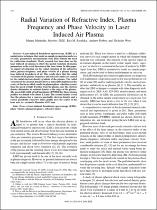 ResearchSpace
ResearchSpace
Radial variation of refractive index, plasma frequency and phase velocity in laser induced air plasma
JavaScript is disabled for your browser. Some features of this site may not work without it.
- ResearchSpace
- →
- Research Publications/Outputs
- →
- Journal Articles
- →
- View Item
| dc.contributor.author |
Mathuthu, M

|
|
| dc.contributor.author |
Raseleka, RM

|
|
| dc.contributor.author |
Forbes, A

|
|
| dc.contributor.author |
West, NA

|
|
| dc.date.accessioned | 2007-07-17T12:50:59Z | |
| dc.date.available | 2007-07-17T12:50:59Z | |
| dc.date.issued | 2006-12 | |
| dc.identifier.citation | Mathuthu, M, et al. 2006. Radial variation of refractive index, plasma frequency and phase velocity in laser induced air plasma. IEEE Transactions on Plasma Science, Vol. 34(6), pp 2554-2560 | en |
| dc.identifier.issn | 0093-3813 | |
| dc.identifier.uri | http://hdl.handle.net/10204/1006 | |
| dc.description | Copyright: 2006 IEEE Institute of Electrical and Electronics | en |
| dc.description.abstract | Laser-induced breakdown spectroscopy (LIBS) is a non-intrusive technique that needs no sample preparation and even recently, quantitative measurements were done without the need for calibration standards. Much research has been done on the laser induced air plasma to study the spatial variation of plasma parameters in the axial direction of the laser beam. In this paper, the authors report investigation on the radial variation of the refractive index, plasma frequency, and phase velocity of a plasma during laser induced breakdown of air. The results show that the radial variations of the plasma frequency and refractive index are caused by the radial electron density gradient of the plasma. The radial variation of the electron density shows a noticeable depletion at the center of the focus which results in plasma phase velocities greater than the speed of light. Further from the plasma core the electron density diminishes to ambient density at the edges of the plasma. The mean full-width at half maximum (FWHM) for these plasma profiles was found to be about 1.2 mm. The results further reveal that the plasma has a concave parabollic electron density and a convex parabollic refractive index profile near the center of the laser axis, i.e., around a diameter of 0.5 mm. | en |
| dc.language.iso | en | en |
| dc.publisher | IEEE Institute of Electrical and Electronics | en |
| dc.subject | Laser-induced breakdown spectroscopy | en |
| dc.subject | Phase velocity | en |
| dc.subject | Plasma frequency | en |
| dc.subject | Refractive index | en |
| dc.title | Radial variation of refractive index, plasma frequency and phase velocity in laser induced air plasma | en |
| dc.type | Article | en |
| dc.identifier.apacitation | Mathuthu, M., Raseleka, R., Forbes, A., & West, N. (2006). Radial variation of refractive index, plasma frequency and phase velocity in laser induced air plasma. http://hdl.handle.net/10204/1006 | en_ZA |
| dc.identifier.chicagocitation | Mathuthu, M, RM Raseleka, A Forbes, and NA West "Radial variation of refractive index, plasma frequency and phase velocity in laser induced air plasma." (2006) http://hdl.handle.net/10204/1006 | en_ZA |
| dc.identifier.vancouvercitation | Mathuthu M, Raseleka R, Forbes A, West N. Radial variation of refractive index, plasma frequency and phase velocity in laser induced air plasma. 2006; http://hdl.handle.net/10204/1006. | en_ZA |
| dc.identifier.ris | TY - Article AU - Mathuthu, M AU - Raseleka, RM AU - Forbes, A AU - West, NA AB - Laser-induced breakdown spectroscopy (LIBS) is a non-intrusive technique that needs no sample preparation and even recently, quantitative measurements were done without the need for calibration standards. Much research has been done on the laser induced air plasma to study the spatial variation of plasma parameters in the axial direction of the laser beam. In this paper, the authors report investigation on the radial variation of the refractive index, plasma frequency, and phase velocity of a plasma during laser induced breakdown of air. The results show that the radial variations of the plasma frequency and refractive index are caused by the radial electron density gradient of the plasma. The radial variation of the electron density shows a noticeable depletion at the center of the focus which results in plasma phase velocities greater than the speed of light. Further from the plasma core the electron density diminishes to ambient density at the edges of the plasma. The mean full-width at half maximum (FWHM) for these plasma profiles was found to be about 1.2 mm. The results further reveal that the plasma has a concave parabollic electron density and a convex parabollic refractive index profile near the center of the laser axis, i.e., around a diameter of 0.5 mm. DA - 2006-12 DB - ResearchSpace DP - CSIR KW - Laser-induced breakdown spectroscopy KW - Phase velocity KW - Plasma frequency KW - Refractive index LK - https://researchspace.csir.co.za PY - 2006 SM - 0093-3813 T1 - Radial variation of refractive index, plasma frequency and phase velocity in laser induced air plasma TI - Radial variation of refractive index, plasma frequency and phase velocity in laser induced air plasma UR - http://hdl.handle.net/10204/1006 ER - | en_ZA |





